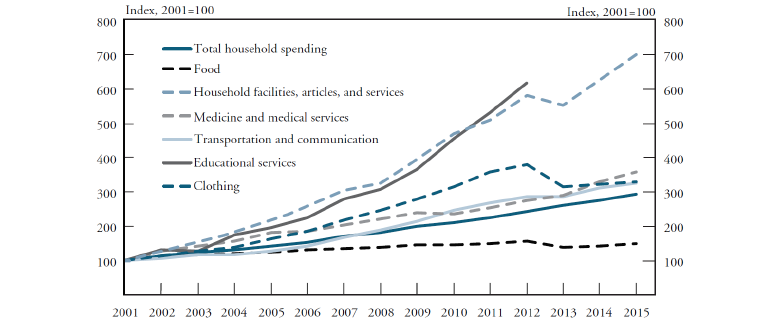Summary
Almost 2,500 years have passed, yet the enduring maxim of Chinese philosopher Confucius that a person who “excels in study can follow an official career” is still very much etched in the minds of many Chinese, who deem education as a conduit towards a better life. That’s why for centuries the pursuit of academic success has remained deeply ingrained in the culture and ethos of the Chinese, who spare no expense on their children’s education.
Life-Changing Tests
The roots behind the notion that a better life that can be achieved through education and hardwork can be traced back to the imperial examination system (科举). Chinese imperial exams, which originated in the Han dynasty, evolved to become a primary recruitment tool for government officials around the midpoint of the Tang dynasty.
From 620-1905, the civil service examinations in the Middle Kingdom played a critical role in the lives of many Chinese intellectuals and became an important symbol of the world’s longest lasting meritocracy. Chinese citizens who yearned for social mobility could take a test set by the government and, upon passing, would receive government appointments. This ensured that the best and brightest minds, regardless of their wealth, status and family background, could serve the country. This meritocratic imperial examination system also prevented the members of affluent and influential families from using their wealth and connections to secure important government appointments1.
Theoretically, a young peasant boy, who studied very hard, could achieve societal elite status after passing the imperial examination and obtaining a government appointment. In 1600, when the population was around 150 million, one out of every 300 Chinese who passed the exam could become a civil licentiate. This ratio fell to one out of 1,000 in 1850, when the population had grown to 350 million2.
Modern Day Equivalent of the Imperial Examinations
In China’s modern society, the imperial examination has been transformed into the National University Entrance Examination, commonly known as the Gaokao (高考). This system was first established in 19523 and, after a hiatus of several years, resumed in 1977 following the Cultural Revolution. Doing well in the Gaokao is the basic prerequisite for entrance into almost all higher education institutions in China.
Since the beginning, the Gaokao has been intensely competitive, with only 300,000 out of the millions of test takers being accepted into universities. Today, over 9 million students in China take the examinations annually, out of which around 3.7 million are accepted into undergraduate courses4. Lasting for more than nine hours over two days4 and testing the students in English, Chinese, mathematics and various other subjects, the Gaokao carries on the centuries-old tradition of offering students the chance to alter their fate and lay a solid path for their future career via sheer hard work.
‘It’s a very narrow path, but it was the only way for me to leave my rural area and prepare for the world. The Gaokao presents many opportunities for children in rural and urban areas. Without it, millions of children from rural backgrounds, including me, would have no hope,’ said Yu Min Hong, founder of US-listed New Oriental Education5.
Gaokao results are extremely important given top Chinese universities’ low admission rates, which are further exacerbated by admission quotas based on geographical locations. In recent years, admission rates into top Chinese universities have averaged less than 3%6. In 2016, Tsinghua University, which is the top university in China, admitted only 296 of the 60,000 students7 from Beijing who took the Gaokao. Of the 50,000 who took it in Shanghai, only 87 were admitted7. This is in stark contrast with an elite US school like Stanford University, which recorded an admission rate of 4.3% in 2017 (2,071 students accepted out of 47,000 applicants8).
Education System in China
China adopts a nine-year compulsory education system, covering primary and middle school. However, in areas populated by ethnic minorities and in a few coastal provinces (e.g. Zhejiang, Guangdong), a 12-year compulsory education system has been introduced on a trial basis. In either case, after the first nine years of compulsory education, students will have another three years in high school before attending university.
Illustration 1: China’s Four-Tied Education Levels

Source: National Bureau of Statistics of China
Compared with other Asian countries, China’s government spending on education was relatively low at around 4% of GDP in 2017. Meanwhile, most of the education resources in China, including schools, are controlled by the government. For example, there were 177,633 primary schools in China in 2016, according to the National Bureau of Statistics of China (NBS), and private schools only represented 3.4% of the total.
In the past ten years, urbanisation has been rising steadily in China, with the rate climbing from 47% in 2008 to 59% in 2017, according to the NBS. The huge inflow of population into city areas has created strong demand for quality education. At the same time, with disposable income on the rise, Chinese families have more resources to pursue quality education for their children. With China’s ‘one-child’ policy resulting in most families having only one progeny to spend on, this has allowed many Chinese children to attend domestic international schools or study overseas.
The Rise of the ‘Study Gods’
Students who are not only good at studying but also exhibit a deep passion for learning are dubbed ‘Study Gods’ (学霸). These students tend to be the crème de la crème who finish at the top of their classes. The pathway to becoming a Study God starts from a tender age in preschool, where students develop the ability to write at least 100 Chinese characters.
The intensely competitive Gaokao results in strong competition in both primary school entry tests and high school examinations, as students who are able gain entrance to ‘key schools’ increase their odds of being admitted to top universities. In order to gain an edge over their peers, students spend endless hours studying and attending supplementary classes. Factoring in this extra study, Chinese primary and secondary school students spend an average of 8.6 hours per day9 in school, with some students studying up to 12 hours9 a day.
Relevant data demonstrates that parents spare no expense on their children’s education. In 2003, Chinese families spent 12.6% of their household budget on education, making it the second highest household expense after food8. According to iResearch, about 60% of middle-class students in China attend tutoring classes, more than 62% of whom attend two or more classes. On average, more than 78% of the middle class in China spend more than RMB 10,000 (USD 1,540) annually on after-school tutoring6.
Public and Private Expenditure on Education in China
Expenditure on education in China has grown at a rapid pace in recent years. In 1999, the Chinese government spent 1.88% of GDP on education. However by 2016, this number had ballooned to above 4%10, which was in line with the global average. According to the UNESCO Institute of Statistics, global government expenditure on education as a percentage of GDP was 4.88%11 in 2014. Therefore, compared to developed countries, and considering the particular importance of education there, China still has room for growth in terms of public educational spending. This is in particular attributable to the fact that the proportion of 25-34 year olds in the country that have tertiary education is still low relative to OECD nations.
Likewise, private spending in education has also increased substantially in the world’s most populous nation, driven by parents’ desire to provide their children, via supplementary classes, with an academic edge over their peers. In 2015, the overall value of the private education market in China was estimated at USD 172.5 billion, and it was anticipated to grow to USD 320 billion by 202012. Since 1996, Chinese consumer spending on education has grown at a faster rate, year-on-year, than aggregate household expenditure. According to data collected by researchers Jun Nie and Andrew Palmer of the Kansas City Federal Reserve Bank, China’s household expenditure on educational services has outgrown any other spending category since 2001 (see Illustration 2).
Illustration 2: China’s Real Average Household Expenditures from 2001 to 2015

Note: All series are deflated by Chinese CPI
Source: Nie, J and Plamer, A, (2016), Consumer Spending in China: The Past and the Future, China National Bureau of Statistics and Haver Analytics
The proportion of household income spent on education is significantly higher in China than in the US, according to CLSA13, which observed that such expenditure in China tends to increase when household income grows, but still remains resilient when income falls.
New Regulations to Level the Playing Field
In the past year, the Chinese private education sector has been plagued with daunting new regulations, the three most important of which were the following: (1) Implementation Details of Law for Promoting Private Education in China (Draft for Review) (“Implementation Details”), published in mid-August 2018; (2) General Office of State Council’s Opinion on Regulating the Development of After-school Training (“AST” ) Institutions (“AST Opinions”), published at end-August 2018; and (3) State Council’s Opinion on Deepening Reform and Development of Pre-school Education (“Pre-school Opinions”), published in mid-November 2018.
These new regulations have common themes—to reduce the burden on students and provide equal opportunities for everyone. For instance, after-school tutoring (AST) classes are now under additional scrutiny, and operators have to obtain individual business operation licenses for each branch. In addition, all teachers need to be licensed. We are of the view that the regulations are forcing a consolidation in the sector and that they will eventually benefit the bigger, well-established players. While the costs of running the AST business have increased, the barriers to entry into the industry have also been raised. According to a circular14 by the Chinese government, more than 10% of disqualified schools were closed at the end of 2018, with the remainder having received orders to alter their business models to comply with regulations. The government has also come up with black lists and white lists for companies in the AST sector.
The Chinese government intends to level the playing field so that less-wealthy students won’t be disadvantaged. It is also trying to ensure universal access to kindergartens. The government targets 85% gross enrollment rates for kindergartens by 2020, out of which public kindergartens should account for 80%.
Despite the regulatory tightening, we remain positive on China’s overall private education sector, which has more room for growth given the country’s early stages of development. In our view, resilient leaders in this sector are likely to increase market share in the near term and emerge as stronger players, as consolidation forces weaker, lower-quality competitors to exit the AST industry. We also believe the market is currently overestimating the regulatory risk in the AST sector, while underrating its secular long-term growth potential.
With the scalability of their business models, coupled with robust consumer demand, many high-quality AST operators in China could enjoy an enduring period of growth. All in all, Chinese families will continue to enroll their children in AST classes and spend more on extracurricular classes given their deep desire to help their children gain access to top-ranked schools.
Without a doubt, the national obsession with grades in China isn’t merely a passing fad, but it is tattooed into the Chinese DNA. Students are hopeful that a better life awaits them by means of higher education and professional qualifications. As the wise Confucius passionately proclaimed: ‘Education breeds confidence. Confidence breeds hope.’
1Source: What Was Imperial China's Civil Service Exam System?, Kallie Szczepanski, 2019
2Source: Berkshire Encyclopedia of China, 2009
3Source: The Imperial Examinations of Modern China, Hannes Björn Hafsteinsson, 2016
4Source: Baidu ![]()
5Source: Gaokao: how one exam can set the course of a student’s life in China, Zhuang Pinghui, 2017
6Source: China Education Sector, Deutsche Bank, 2018
7Source: For Survivors of a 9-Hour Chinese Exam, a Door Opens to America, Tiffany May, 2018
8Source: Stanford Undergraduate Admission ![]()
9Source: The Imperial Examinations of Modern China, Hannes Björn Hafsteinsson, 2016
10Source: The Analysis on Educational Expenditure of China, Li Yinan, 2017
11Source: World Bank, 2019
12Source: China Education Sector, Citibank, 2017
13Source: Critical Mass, CLSA, 2018
14Source: Ministry of Education of the People's Republic of China ![]()



